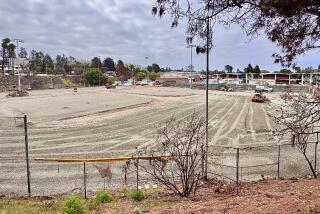The Fire This Time
- Share via
Flames that ate through Gabrielino High last weekend touched me in a special way.
The smoking debris, the charred timbers, the damp odor of wet ashes brought back memories of another fire a long time ago.
It burned a wooden portable to the ground that had been our third-grade homeroom in the overcrowded conditions of a working-class neighborhood.
I remember coming to school and standing there looking at the ruins of what had once been a familiar place and thinking, “Why’d they do that?”
I’m still asking the same question.
Back then it was an isolated incident of arson committed by a student who never could offer an adequate explanation for his crime. Today, vandalism at schools isn’t that rare. And there still isn’t an adequate explanation.
Last year in California, vandals caused $17 million worth of damage to the state’s schools. There was some trumpeting to the announcement because it had come down from $22 million the year before.
But that’s still one hell of a lot of burning and smashing. That’s still one hell of a lot of paint-spattering. That’s still one hell of a lot of window-breaking.
Why’re they doing that?
*
No one is certain that vandals were responsible for the $2-million fire that destroyed an entire wing of classrooms in San Gabriel. Fire Chief I.W. Sweet would only say that it’s suspicious in view of what has happened to other schools throughout California. They’re investigating.
But there’s little question that vandals caused $1 million worth of damage at Whittier High last month when they set the gym on fire. Witnesses saw teenagers running from the scene.
And there’s no question that it was vandalism at La Puente High three weeks ago. In a $25,000 rampage that left the small community startled by its savagery, someone shattered the school’s 36-year-old mosaic logo, gouged doors, overturned phone booths and splashed paint everywhere.
Indications are that the perpetrators were students, the principal said, because they knew where everything was kept. Their rampage was precise and methodical.
In both situations, students and teachers alike felt victimized by the crimes. At Gabrielino, English teacher Kathryn Konoske said, “My home is gone.” At La Puente, student body president Latoya Lewis said, “My house has been trashed.”
Their reference to school as a home, that special place I remembered from long ago, offers reason to some why kids turn there to vent their rage.
Psychotherapist Michael Aharoni, who has worked with children for 20 years, speculates that they’re acting out resentments against their own homes, where parents have somehow failed them.
USC psychologist JoAnne Farver sees it as a cultural collapse of schools as a second home, a loss of community and a “disconnection” of kids from school. She added: “They just don’t respect it anymore.”
*
Talking to psychologists, you get all kinds of reasons why kids do what they do. They blame society, they blame parents, they blame the media, they blame the government, they blame diet . . . they’d probably blame the weather if they could figure out any kind of linkage.
State Sen. Hilda Solis, who graduated from La Puente in 1975, suggests “negative energy” as a cause for school vandalism. “There’s anger going on,” she said the other day. “Parents, teachers and counselors ought to be talking about this. . . . “
All agree that it hasn’t always been this way. “I used to walk to school,” Farver said. “We had school carnivals and other activities. School was a base. We knew each other. That’s not true anymore. I don’t know why.”
There was something else back then too. It was called pride. And it was called self-responsibility. You took pride in a school even if it was only a bleak set of portables. And you took responsibility for your actions even when it hurt.
And maybe there was a different attitude from the schools too. Teaching was more than a job, it was a career. Where parents failed, the school stepped in. Teachers knew us. They were involved in our lives. “No one cares about anything anymore,” Farver said.
Some of us do. And I guess that’s why we keep wondering as smoke rises over the homes of our children, as the world gets angrier and as our involvement with each other decreases, why’re we doing this to ourselves?
*
Al Martinez’s column appears Sundays and Wednesdays. He can be reached online at al.martinez@latimes.com
More to Read
Sign up for Essential California
The most important California stories and recommendations in your inbox every morning.
You may occasionally receive promotional content from the Los Angeles Times.













